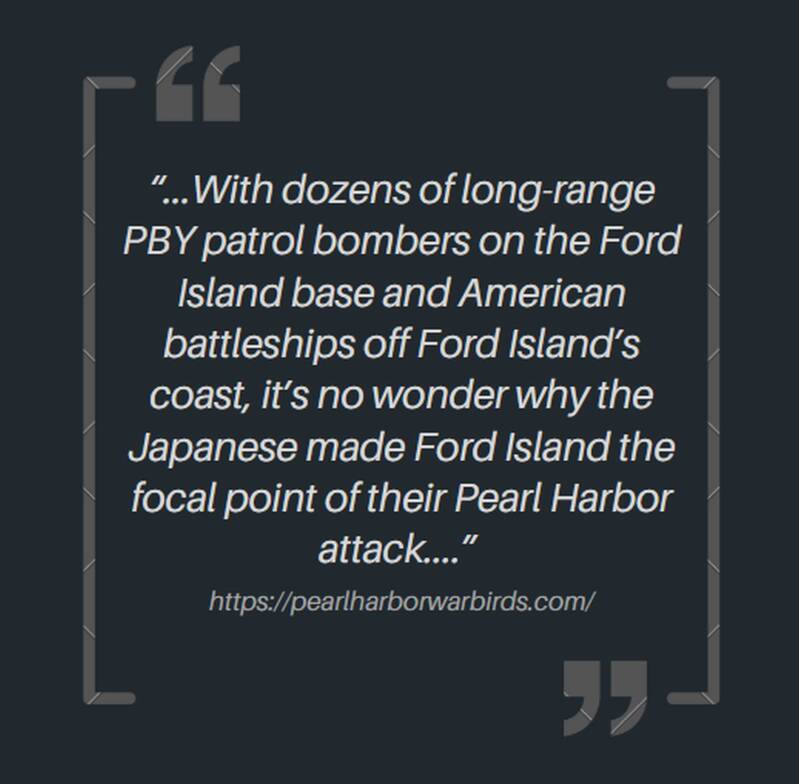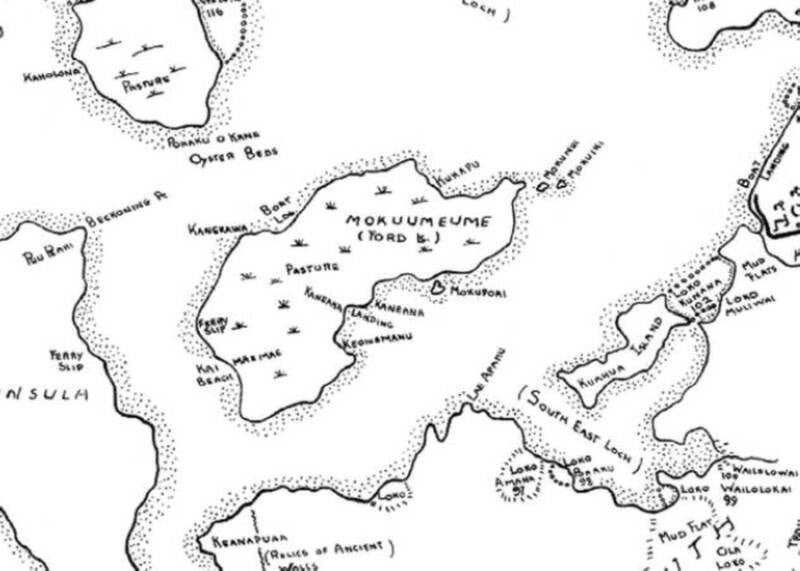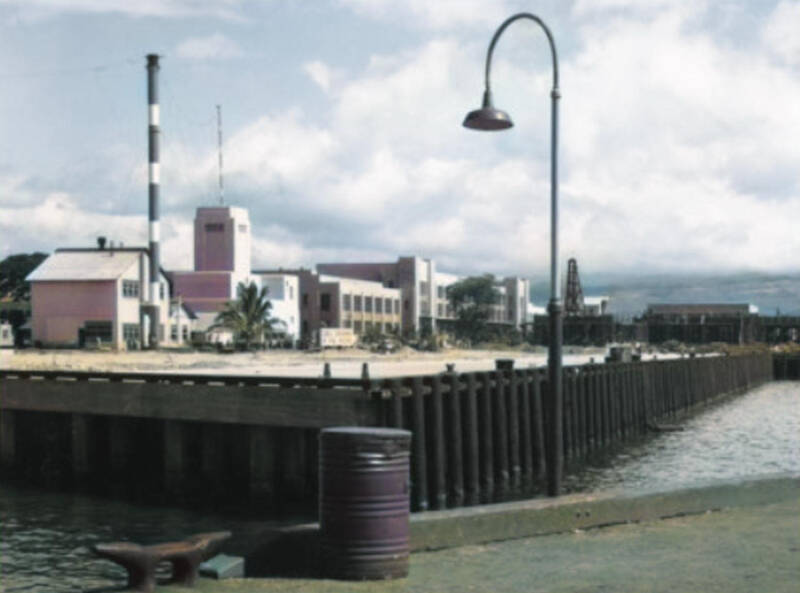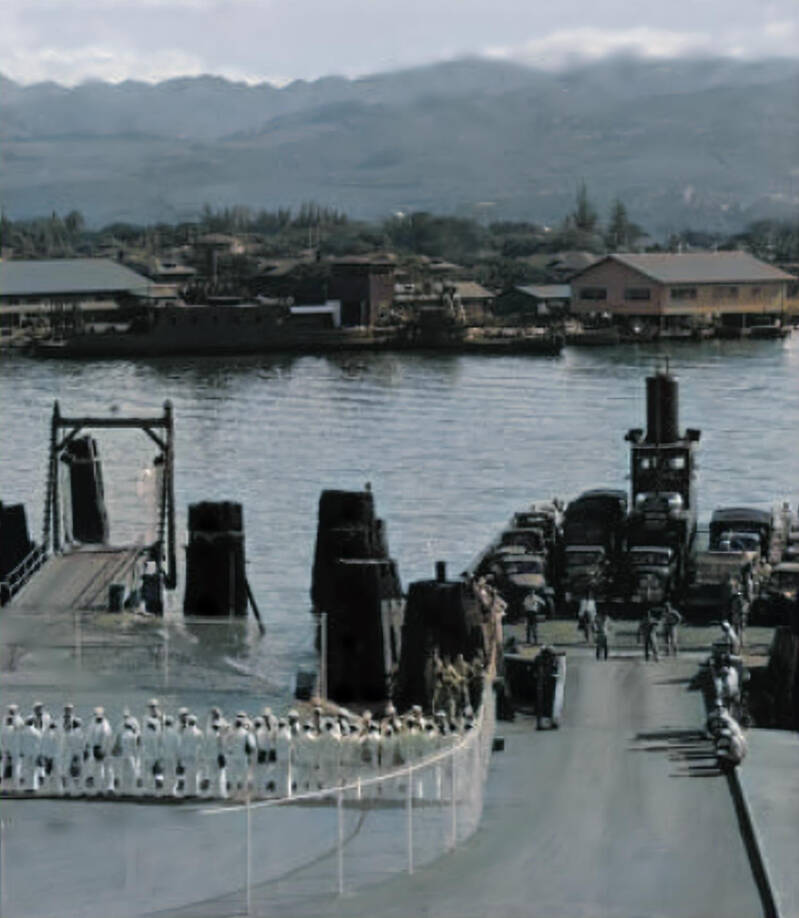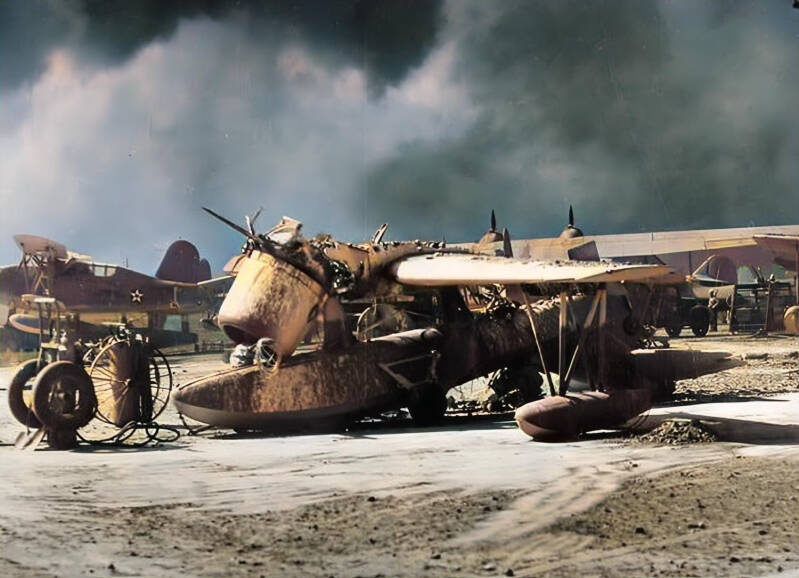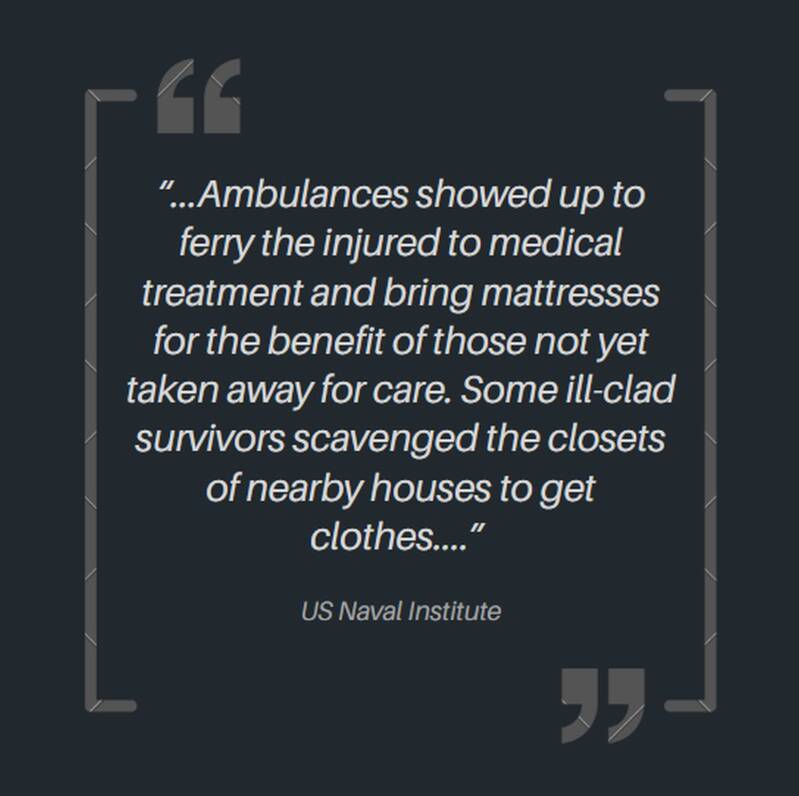Surprise Inferno
The Devastating Attack on Ford Island Naval Base
Ford Island, located in the heart of Pearl Harbor, played a pivotal role during one of the most significant events in American history - the Japanese attack on the 7th December 1941.
As a strategically positioned naval base, Ford Island was home to critical military assets, including battleships, airfields, and personnel. Its importance made it a primary target during the surprise assault that would thrust the United States into the Second World War.
Utter devastation: The Japanese attack on Pearl Harbor on the 7th December 1941 - an event which would bring the United States into the Second World War.
...unleashing devastation...
National Oceanic and Atmospheric Administration approach map for Pearl Harbor showing Ford Island in the northeast section.
On that fateful morning, Ford Island found itself in the direct path of the Japanese attack.
The skies over Pearl Harbor darkened with waves of aircraft, unleashing devastation upon the battleships moored nearby and the airstrips on the island itself.
The chaos that ensued highlighted both the vulnerability of the base and the heroism of those who defended it.
This article will explore the strategic importance of Ford Island leading up to the attack, the harrowing events of the 7th December, and the aftermath that left a lasting impact on the naval base.
By examining these elements, we can better understand how Ford Island’s experiences during the Pearl Harbor attack not only shaped the course of the Second World War Ibut also became a symbol of sacrifice and resilience in American history.
The aftermath of the attack at Ford Island - wrecked hangars and destroyed aircraft.
An Island History
Ford Island, nestled in the middle of Pearl Harbor, has a rich history that predates its pivotal role in the Second World War.
Originally known as Moku‘ume‘ume, meaning “Island of Strife,” it was once a part of Hawaiian legend and used by the native population for agriculture and fishing.
In the late 19th century, as the Kingdom of Hawaii fell under U.S. influence, Ford Island began to shift from an agricultural hub to a military outpost.
Map of Mokuʻumeʻume, compiled from maps dated 1873 to 1915.
: This house, photographed in the late 1800s
or early 1900s, uses both traditional materials, the pili grass thatching, and post-contact elements, such as the paneled door. The open-sided roofed area in the rear also shows the influence of western-style buildings.
https://historichawaii.org/wp-content/uploads/Ford-Island-Trail-Historical-Markers_reduced.pdf
1922 - two native Hawaiians with outrigger canoes at the shoreline in Honolulu.
https://www.vintag.es/2013/08/old-photos-of-hawaii-from-before-it.html
...a key site for seaplane operations...
In 1916, the U.S. Navy purchased the island from Dr. Seth Porter Ford’s estate, after whom the island was renamed. This acquisition marked the beginning of its transformation into a naval aviation base.
By the early 1920s, Ford Island had developed into a vital component of the U.S. Pacific Fleet’s operations. It became a key site for seaplane operations, airfield development, and battleship mooring.
The island’s flat terrain and central location within Pearl Harbor made it an ideal hub for aviation training and experimentation.
Earliest known aerial photo of Ford Island taken on the 16th December 1918.
...were crucial for long-range reconnaissance missions....
Throughout the 1930s, Ford Island saw significant upgrades to bolster its role as a strategic naval aviation base.
One of the major improvements was the expansion and modernization of the airfield.
The runway was extended to accommodate larger aircraft, such as the PBY Catalina patrol bombers, which were crucial for long-range reconnaissance missions.
Additionally, new concrete aprons were added to provide more parking and operational space for aircraft.
Enlisted US Naval personnel help construct new houses on the island. During the 1920s and 1930s, Ford Island saw the development of housing to accommodate the growing number of military personnel stationed there. Quarters were built for officers and enlisted men, including Nob Hill and Chief Petty Officer (CPO) quarters, reflecting the island's increasing strategic importance.
https://historichawaii.org/wp-content/uploads/2019/05/03_Page_1.jpg
By the 1920s, the US Navy was building up its Naval Air Station on Ford Island. As part of this growth, in 1922 the Navy began construction on the north end of the island for three married officers’ homes (Quarters A, B, and C), later known as “Nob Hill.” Pictured is quarters in Quarters A (Facility #321). The Nob Hill homes were hit with shrapnel and damaged during the Pearl Harbor attack on December 7, 1941
...facilitated the launch and recovery of seaplanes...
The construction of Hangars 6 and 7 in the mid-1930s provided vital maintenance and storage facilities for the growing fleet of naval aircraft.
These hangars were designed to support a wide variety of aircraft, enabling more efficient repairs and upkeep.
Ford Island also saw the development of a seaplane ramp, which facilitated the launch and recovery of seaplanes directly from the harbor waters, enhancing the base's operational flexibility.
U.S. Naval Base, Pearl Harbor, Hangar 6, South End of Ford Island. Hangar 6 on Ford Island, built in the mid-1930s, served as a crucial maintenance facility for naval aircraft. During the Pearl Harbor attack, it was heavily damaged but continued to play a vital role in aircraft operations throughout the war.
...increasing number of personnel stationed on the island...
Gasoline Wharf on Ford Island with new Gasoline tanks in the background. Gasoline Wharf on Ford Island was developed to support naval aviation operations. It provided essential fueling capabilities for seaplanes and patrol bombers stationed there, contributing to the island's role as a crucial aviation hub in the Pacific.
https://historichawaii.org/wp-content/uploads/2019/05/04_Page_2.jpg
Further infrastructure improvements included the addition of new barracks to house the increasing number of personnel stationed on the island and the installation of an advanced communications network to support command and control functions.
A fuel depot was also constructed, ensuring that the island could support extended flight operations without relying on external resources.
These enhancements made Ford Island a crucial component of the U.S. Navy’s Pacific operations by 1940.
The Fire Station (Facility 42) on Ford Island, completed in 1936, played an important role during the Japanese attack on Pearl Harbor. The fire station was crucial during the Japanese attack on Pearl Harbor. Firefighters stationed there responded quickly to numerous fires caused by bombs and strafing runs, working tirelessly to extinguish flames and save lives amidst the chaos and destruction surrounding the island.
https://historichawaii.org/wp-content/uploads/2019/05/06_Page_2.jpg
...underscored its strategic importance...
Throughout the 1930s, tensions in the Pacific were rising, and Ford Island’s role became even more critical.
The expansion of the island's airfield, combined with the growing presence of naval vessels, underscored its strategic importance.
On the eve of the Pearl Harbor attack, 6th December 1941, Ford Island was at the height of its operational capacity, serving as a key component in America’s Pacific defenses.
Little did its personnel know that within hours, the island would be thrust into the most significant naval assault in U.S. history, becoming one of the primary targets in the Japanese attack that would alter the course of the Second World War.
The Dispensary was designed by Charles W. Dickey, one of Hawaii's most eminent architects. Built as a clinic for Naval Air Station personnel, it served as a hospital during the attack on Pearl Harbor.
https://historichawaii.org/wp-content/uploads/2019/05/05_Page_1.jpg
The barracks and mess hall building, built in 1935, could house 1000 enlisted men.
A US Stronghold
By December 1941, Ford Island had become a central hub for U.S. military operations in the Pacific, playing a crucial role in both naval and air operations.
The island hosted a mix of naval and aviation units, making it a vital component of America's defenses in the region.
One of the most prominent military units on Ford Island was Patrol Wing Two (PatWing-2), which was responsible for reconnaissance and long-range patrols across the Pacific.
Equipped with PBY Catalina seaplanes, this unit monitored Japanese naval movements, ensuring American forces could respond to potential threats.
Additionally, Ford Island was home to the Pacific Fleet’s naval aviation forces, with squadrons of bombers, fighters, and patrol planes stationed at its airfield.
These aircraft included the Douglas TBD Devastators, Vought SB2U Vindicators, and Boeing B-17 Flying Fortresses.
The landmark tower of the operations room on Ford Island (pictured here in 1942). It would remain in service throughout the Japanese attack on the 7th December 1941. At the time of the attack, the upper tower had not yet been completed.
US Navy, Bureau of Yards and Docks, from National Archives
A mechanic works on a Consolidated PBY Catalina at Naval Air Station , Pearl Harbor. PBY Catalina seaplanes stationed at Ford Island were crucial for long-range reconnaissance missions. During the Pearl Harbor attack, many were destroyed on the ground, severely impacting the U.S. Navy's ability to conduct reconnaissance and search operations in the Pacific.
Two men hold up the end of a seaplane being repaired in the Engine and Overhaul Shop (facility 39). It responsible for maintaining and repairing aircraft engines, ensuring operational readiness and efficiency of the naval aviation fleet stationed at Pearl Harbor during its active years.
US Navy, Bureau of Aeronautics, 14th Naval District Photo Collection
https://historichawaii.org/wp-content/uploads/2019/05/07_Page_1.jpg
The Boathouse, built in 1936 on Ford Island, served as a facility for storing, maintaining, and deploying small boats used for daily naval operations, transportation, and patrol duties within Pearl Harbor, enhancing operational efficiency and accessibility.
US Navy, Bureau of Aeronautics, 14th Naval District Photo Collection
https://historichawaii.org/wp-content/uploads/2019/05/06_Page_1.jpg
...represented a significant portion...
1922 map of the Naval Facilities on Ford Island.
US Navy, Bureau of Yards and Docks, from National Archives
https://historichawaii.org/wp-content/uploads/2019/05/07_Page_1.jpg
1937 photo of the Naval Facilities on Ford Island.
US Navy, Bureau of Yards and Docks, from National Archives
https://historichawaii.org/wp-content/uploads/2019/05/07_Page_1.jpg
The Pacific Fleet's battleships and cruisers, such as the USS Arizona, USS Oklahoma, and USS California, were strategically moored around Ford Island in an area known as Battleship Row.
This lineup represented a significant portion of the U.S. Navy's Pacific power at the time. These vessels formed a protective circle around Ford Island, which served as their logistical and operational hub.
Ford Island provided essential support services, including fuel, ammunition, and maintenance, making it a vital base for fleet operations.
The close proximity of these battleships to the island demonstrated the U.S. Navy’s reliance on Ford Island as a central point for coordinating Pacific defenses and naval activities in the region.
This concentration of naval assets made Battleship Row a primary target during the Japanese attack on Pearl Harbor, leading to catastrophic losses and significant damage to the Pacific Fleet’s power.
Ford Island and surrounding facilties.
https://www.pearlharbortours.com/oahu/pearl-harbor/pearl-harbor-aviation-museum/
...played a significant role in the defense and coordination of military assets...
Aerial photograph of Ford Island, looking about NNE, taken 10 October 1941 - approximately two months before the Japanese attack. The Naval Air Station occupies most of the Island, with the seaplane base on the point at the near right. There are about twenty PBY patrol planes parked there. USS Enterprise (CV-6), USS Curtiss (AV-4) and two battleships are tied up along Ford Island's southeastern side, to the right. Aiea is on the far shore in the upper right.
Official U.S. Navy Photograph
Facilities on Ford Island included a state-of-the-art airfield, hangars, seaplane ramps, and maintenance depots to support both naval and aviation operations.
It also had command centers, barracks, and a fuel depot critical to keeping the Pacific Fleet operational.
Rear Admiral Patrick N. L. Bellinger, an experienced aviator and commander of Patrol Wing Two, was one of the key figures overseeing operations on the island.
His leadership played a significant role in the defense and coordination of military assets in the lead-up to the Pearl Harbor attack.
By the eve of December 7, 1941, Ford Island was a bustling military installation, brimming with personnel, advanced equipment, and strategic assets critical to U.S. operations in the Pacific.
Rear Admiral Patrick N. L. Bellinger was the first notice to the outside world of the attack
The F1 Wharf on Ford Island, a vital part of the military infrastructure on the island. Burning oil would set fire to timber pilings on the dock during the Japanese attack on the 7th December 1941.
US Navy, Bureau of Yards and Docks, from National Archives
https://historichawaii.org/wp-content/uploads/2019/05/06_Page_1.jpg
Apart from by air, Boats provided the usual route in and out of the island. Here, servicemen line up to use the ferry. The ferry on Ford Island was essential for transporting personnel, vehicles, and supplies between the island and the mainland of Oahu. It operated regularly, providing a critical link for military and civilian activities on the island.
https://historichawaii.org/wp-content/uploads/2019/05/05_Page_2.jpg

A floodlight tower on Ford Island, used to illuminate the airfield and surrounding facilities, enabling nighttime operations and enhancing security. They provided visibility for aircraft landing, takeoff, and maintenance activities, and also helped deter potential threats by improving overall visibility around the base.
https://historichawaii.org/wp-content/uploads/2019/05/10_Page_2.jpg
The Japanese Attack
The Japanese attack on Pearl Harbor on 7th December 1941, had a profound and devastating impact on Ford Island, a central hub for naval aviation within the harbor.
Ford Island was home to key air and naval installations, making it a prime target during the first wave of the attack.
At 7:55 a.m., the Japanese launched their first wave of aircraft, which included bombers, torpedo planes, and fighters.
Ford Island's airfield and the surrounding ships on Battleship Row were among the primary targets.
The Japanese aimed to destroy as many American aircraft and warships as possible to ensure that U.S. forces couldn’t mount an effective defense or counterattack in the Pacific.
View looking down Battleship Row from Ford Island Naval Air Station, shortly after the Japanese torpedo plane attack. USS California (BB-44) is at left, listing to port after receiving two torpedo hits. In the center are USS Maryland (BB-46) with the capsized USS Oklahoma (BB-37) alongside. USS Neosho (AO-23) is at right, backing clear of the area. Most smoke is from USS Arizona (BB-39).
Official U.S. Navy Photograph
...reduced to smoldering wreckage...
The Japanese attackers focused on crippling the airpower on Ford Island, which housed various squadrons of seaplanes such as PBY Catalinas.
Most of these planes were parked in the open, making them easy targets. Within minutes, many of the planes were reduced to smoldering wreckage, hampering the island's ability to launch reconnaissance or retaliatory strikes.
The Ford Island Operations Building (S84) included a garage, operations and administrative offices, barracks, an areological tower, water tank, and an aircraft control tower.
At the time of the Pearl Harbor attack, Building S84, like many other structures, was still under construction, with only 80% of the aircraft control tower completed.
Smoke rises from burning buildings on Ford Island after the Japanese attack.
https://www.history.com/news/pearl-harbor-1941-from-a-sailors-perspective
View taken from atop a building at Ford Island Naval Air Station, looking over Hanger # 37 toward the Navy Yard, during the Japanese air raid. In the left distance are the mast tops of USS Pennsylvania (BB-38), in Navy Yard Drydock # 1. Mast tops in center are those of USS Nevada (BB-36). Smoke is from Nevada and the burning destroyers Cassin (DD-372), Downes (DD-375) and Shaw (DD-373). Planes in the foreground include two Grumman J2F and one Douglas RD-3. Two SBDs are inside Hangar # 37.
Official U.S. Navy Photograph
...scaffolding around the tall water tank forced low-flying Japanese planes to veer away...
Due to the unfinished upper tower, the areological tower atop Building S84 was temporarily used as a control tower to direct aircraft operations.
Despite being strafed during the attack, personnel in the Operations Building S84 continued to guide U.S. aircraft in and out of the Ford Island airstrip.
Surrounding construction scaffolding around the tall water tank forced low-flying Japanese planes to veer away, as some attackers flew as low as 40 feet.
Lisa Ferdinando, https://www.defense.gov/News/News-Stories/Article/Article/1026523/
Controllers on the lower deck of the temporary tower managed to direct USS Enterprise SBD Dauntless scout planes arriving amidst the chaos of the attack.
Like many structures on Ford Island, Building S84 was still new at the time of the attack, with only 80% of the aircraft control tower complete. Because the upper control tower was not complete, the aerological tower on top of Building S84 was temporarily used as a control tower to direct aircraft. The Operations Building S-84 was strafed during the attack while controllers continued to guide U.S. aircraft in and out of the Ford Island airstrip.
https://www.pearlharboraviationmuseum.org/news/blog-archives/history-of-ford-island-control-tower/
...mistakenly shot down by American anti-aircraft fire...
Despite the intensity of the Japanese attack, Operations Building S84 and its control tower remained standing throughout the ongoing assault.
Several planes from the aircraft carrier Enterprise, returning to Hawaii after a mission to Wake Island, arrived during the Pearl Harbor attack and were mistakenly shot down by American anti-aircraft fire.
H. L. Young, commander of the Enterprise air group, attempted to coordinate communications between Ford Island, the carrier, and the incoming aircraft from the control tower.
The carrier USS Enterprise. During the Pearl Harbor attack, aircraft from the USS Enterprise arrived amidst the chaos. Some were mistakenly shot down by friendly fire, as they were returning from a mission to Wake Island.
Sandbagged .30 caliber machine gun emplacement with gun crew on alert, at the seaplane base near Ford Island's southern tip, soon after the Japanese attack. Note wind sock atop hangar at right, PBY patrol plane warming up by the corner of the hangar, another PBY in the center distance, and three SOC floatplanes at left with the beached battleship Nevada (BB-36) beyond. Sandbags are marked Permanente.
Official U.S. Navy Photograph
...efforts to alert as many ships and anti-aircraft batteries as possible...
View of the Pearl Harbor drydocks from Ford Island during the Japanese air attack, 7 Dec 1941. Note seaplane tender USS Avocet in the foreground and battleship USS Nevada almost broadside to the channel.
However, he found the communication systems on Ford Island inadequate for reaching the Enterprise, which he believed contributed to the friendly fire incidents.
Despite these challenges, he made efforts to alert as many ships and anti-aircraft batteries as possible.
Within hours, aircraft from both Enterprise and Ford Island were airborne again, conducting searches for the enemy attackers.
Unfortunately, some of these planes were again targeted by friendly fire upon their return, as the island's defenses remained on high alert.
A wrecked U.S. Navy Vought OS2U Kingfisher at the Naval Air Station Ford Island, Pearl Harbor, Hawai'i - a victim of the Japanese attack.
https://pearlharborwarbirds.com/ford-island-pearl-harbor-attack-in-photos/
...sustained heavy damage...
The destruction on Ford Island was severe. The Japanese attack left over 30 aircraft destroyed, many of which were vital for long-range patrols and reconnaissance.
Hangars, maintenance facilities, and fuel storage areas also sustained heavy damage.
The surrounding ships, especially those along Battleship Row, such as the USS Arizona, USS California, and USS Oklahoma, were also severely damaged or sunk.
Battleship Arizona burning and settled on the bottom as seen from Ford Island, Pearl Harbor, Oahu, Hawaii, Dec 7, 1941.
...as they swooped in for bombing runs and strafing attacks...
The USS Arizona suffered the most catastrophic loss when a bomb penetrated its forward magazine, causing a massive explosion that killed over 1,100 sailors. The destruction of these ships further compounded the damage to Ford Island, as the area was engulfed in flames and smoke.
Despite the surprise and chaos, defenders on Ford Island attempted to fight back. Some personnel manned anti-aircraft guns and fired on Japanese planes as they swooped in for bombing runs and strafing attacks.
However, the speed and ferocity of the assault overwhelmed the defenses, and many defenders were killed or injured.
Casualty numbers on Ford Island mirrored the broader devastation of the Pearl Harbor attack, where a total of over 2,400 Americans lost their lives, with many hundreds more wounded.
An ammunition party working on Ford Island during the Japanese raid. During the Japanese attack on Pearl Harbor, anti-aircraft gunners on Ford Island fought bravely, firing at incoming enemy planes despite being heavily outnumbered and underprepared, with many gunners making heroic efforts under intense fire.
https://pearlharborwarbirds.com/ford-island-pearl-harbor-attack-in-photos/
Civilians under fire
Residents of Ford Island found themselves at the epicenter of the Japanese attack on Pearl Harbor. Initially, the low-flying planes seemed unusual but not alarming.
However, as soon as the residents noticed the rising sun emblem on the aircraft, they realized the gravity of the situation.
The attack came swiftly and devastatingly. Witnesses vividly recall the deafening explosion of the USS Arizona, which was struck just yards away from their homes.
View of Pearl Harbor from Ford Island with the dredge 'Turbine' in the middle of the South Channel, 7 Dec 1941; note Pennsylvania in center of background and Shaw burning at right.
...the loudest noise I have ever heard...
“It was the loudest noise I have ever heard. Windows shattered, and china dishware fell out of the cabinets,” remembered Tom Davey, a nine-year-old Nob Hill resident at the time.
The blast from the Arizona created chaos, with homes on the island being showered with shrapnel and debris, and smoke filling the air.
Chief Petty Officer Bungalows on Ford Island - photographed here in 1924. They would be in the firing line during the Japanese attack. The bungalows, built by the Navy, were located along the shoreline of Battleship Row, near where the USS Arizona and USS West Virginia were moored on the 7th December 1941. These houses were close enough that sailors on board the USS Tennessee were able to bounce potatoes off the roofs of the houses!
http://remembrance.pacifichistoricparks.org/2017/07/31/historic-chief-petty-officer-bungalows/
...bombs rained down on Battleship Row...
As the surprise attack unfolded, fathers desperately rushed to their duty stations, while terrified mothers and children sought safety in the basement of Admiral Bellinger’s home, Quarters K, formerly known as Battery Adair.
From this makeshift shelter, they watched in horror as Japanese aircraft repeatedly swooped towards the ships, bombs plummeting down on Battleship Row, where the USS Arizona and other US ships were under attack.
During the Japanese attack on Pearl Harbor, Battery Adair on Ford Island served as a shelter for families of naval personnel. They took refuge in its basement, which was part of Admiral Bellinger’s residence, witnessing the bombardment of Battleship Row and the nearby USS Arizona.
Library of Congress
...sailors were severely burned, covered in oil, and injured...
Residents of the Nob Hill and Chief Petty Officers (CPO) quarters quickly offered refuge to Navy personnel who managed to escape the burning ships.
Many of these sailors were severely burned, covered in oil, and injured.
They joined the families in the Bachelor Officers’ Quarters (BOQ) and the “dungeon” of Quarters K. “This was my first exposure to men covered with oil, burned, wounded, and crying out in pain,” Davey recalled.
A bomb landed in the courtyard near to the dispensary during the Second wave of the Japanese attack, creating a crater 7 foot deep. Miraculously, no one was hurt, despite there being 150 casualties sheltering in the dispensary, victims of the Japanese attack.
https://historichawaii.org/wp-content/uploads/2019/05/05_Page_1.jpg
...the community’s resilience shone through...
Meanwhile, residents of Luke Field Housing witnessed the tragic sinking of the USS Utah, a target-towing ship mistakenly targeted as an aircraft carrier.
The ship capsized just offshore from their designated shelter at the nearby BOQ.
In the aftermath, families were allowed only a brief return to their homes to gather essential belongings before being evacuated to safer locations.
Despite the devastation, the community’s resilience shone through, as they supported each other and the wounded during one of the darkest days in American history.
A capsized USS Utah - a former Battleship converted to training duties - which was attacked by Japanese aircraft after mistaking it for an aircraft carrier. Even civilians who escaped physical harm during the Japanese attack were still witness to the horror as it unfolded around them. Residents of Luke Field Housing on Ford Island witnessed the capsizing of the Utah after the Japanese aerial attack
https://www.denverpost.com/2016/12/06/photos-attack-on-pearl-harbor-december-7-1941/
Aftermath
In the aftermath of the Japanese attack on Pearl Harbor, the scene on Ford Island and surrounding areas was one of widespread devastation.
The attack left the island, home to critical air and naval facilities, in ruins.
Over 30 aircraft, including PBY Catalina seaplanes, were destroyed on the ground, leaving Ford Island's airfield a smoldering wreck.
Craters from bombs dotted the landscape, and many hangars and support buildings were heavily damaged or completely destroyed.
Ariel photograph of Ford Island Naval base taken 3 days after the Japanese attack.
Damaged hangar on Ford Island after the attacks.
...catastrophic explosion caused widespread fire and debris...
Fires raged throughout the area, fueled by the oil leaking from damaged ships on Battleship Row, including the USS Arizona, whose catastrophic explosion caused widespread fire and debris.
The waters surrounding Ford Island were also on fire due to fuel spilling from the ships, further complicating rescue efforts.
Groundcrew attempt to tackle the damage after the Japanese raid. Smoke plumes can be seen in the distance - a result of the Japanese strikes on Battleship Row.
https://pearlharborwarbirds.com/ford-island-pearl-harbor-attack-in-photos/
...some suffering severe burns and injuries...
Casualties were severe. Scores were killed in the attack, with many of those losses coming from the sinking of the Arizona and other battleships.
Many more were wounded, some suffering severe burns and injuries from shrapnel and explosions.
On Ford Island, survivors worked quickly to aid the wounded, dragging them from burning wreckage and providing first aid under extreme conditions.
Medical personnel on the island and at nearby facilities were overwhelmed by the sheer number of casualties, but they worked tirelessly to treat the injured.
The USS Arizona burning furiously in Pearl Harbour (Pearl Harbor) after the Japanese attack. To the left of her are USS Tennessee and the sunken USS West Virginia.
Hulton Archive/Getty Images https://www.mysanantonio.com/news/local/slideshow/The-1941-attack-on-Pearl-Harbor-188008.php
Ground crew examine a downed Japanese Navy Type 99 Carrier Bomber, an Aichi D3A “VAL” at Pearl Harbor. This plane was launched from the Japanese aircraft carrier Kaga.
https://pearlharborwarbirds.com/ford-island-pearl-harbor-attack-in-photos/
...in extreme cases, personnel were transferred to other military and civilian hospitals...
Following the attack, medical evacuations were prioritized. Those who were wounded on Ford Island were moved to nearby hospitals and medical facilities on the main island of Oahu.
The U.S. Naval Hospital at Pearl Harbor was one of the key locations where injured personnel were treated, and in extreme cases, personnel were transferred to other military and civilian hospitals across the island.
Evacuations were also necessary for some non-essential personnel to ensure that resources could be concentrated on recovery efforts and military operations.
However, Ford Island itself, being a central naval air station, did not see a complete evacuation of its personnel, as it remained operational in the days following the attack, despite the devastation.
The aftermath of the attack on Ford Island.
https://pearlharborwarbirds.com/ford-island-pearl-harbor-attack-in-photos/
The destruction of Ford Island’s facilities and aircraft crippled U.S. reconnaissance and air capabilities in the Pacific in the immediate aftermath of the attack.
However, despite the devastation, Ford Island and Pearl Harbor would eventually become symbols of resilience and recovery, as the United States rapidly rebuilt its Pacific Fleet in the months that followed.
Recovery and Role in the War
After the devastating attack on Pearl Harbor, Ford Island played a crucial role in the U.S. Navy’s recovery efforts and continued to be of strategic importance throughout the Second World War.
Despite the extensive damage, the island’s airfield and naval facilities were quickly repaired, with rebuilding efforts prioritized as part of the broader restoration of Pearl Harbor.
After the Japanese attack, earth-covered shelters were built around the Administration Building and parts of it were protected by sandbags walls.
https://historichawaii.org/wp-content/uploads/2019/05/06_Page_2.jpg
Aerial view of Ford Island from over Pearl City Peninsula looking toward Diamond Head in the distance, 1 Aug 1942. Escort carrier USS Long Island and Yorktown-class carrier USS Hornet are moored to Ford Island.
This bombproof shelter was built in 1942 in anticipation of another attack by the Japanese. The camouflage net on the six-foot thick concrete roof covered an anti-aircraft
gun position. Within the windowless four-foot thick walls of the bottom level are air filters and decontamination rooms that were designed to protect against a gas attack
https://historichawaii.org/wp-content/uploads/Ford-Island-Trail-Historical-Markers_reduced.pdf
In the months following the attack, Ford Island's airfield was restored, and it continued to serve as a key hub for naval aviation in the Pacific.
The U.S. Navy rapidly expanded the island's infrastructure, transforming it into an even more vital base for reconnaissance, patrols, and air operations.
PBY Catalina seaplanes and other aircraft used the island for long-range patrols, playing a crucial role in scouting enemy movements, particularly in the vast Pacific theatre.
Ford Island’s central location within Pearl Harbor remained critical to naval strategy, serving as a base for aircraft that were instrumental in countering the Japanese advance across the Pacific.
Ford Island, Pearl Harbor, early 1942. Note the newly constructed blast proof revetments built after the Japanese attack on 7th December 1941.
Long-term changes to the base occurred as part of the broader militarization of Pearl Harbor. Additional defences, including anti-aircraft guns and reinforced infrastructure, were installed to prevent a repeat of the 1941 attack.
Ford Island’s role evolved further during the war, becoming a centre for training new pilots and crews, as well as serving as a logistics and repair hub for damaged ships returning from battle.
After the Second World War, Ford Island continued to serve as a naval base, although its role diminished with the advent of modern technology and air warfare.
Today, it is a historic site, with parts of it preserved as part of the Pearl Harbor National Memorial, commemorating the lives lost and the resilience of the U.S. Navy during the war.
Ford Island, Pearl Harbor shipyard, and Hickam Field, Oahu, Hawaii post-war, 4th August 1951. Note oil slick streaming from the sunken Arizona, upper left.
Aerial view of shipping in the Pearl Harbor Navy Yard repair basin with Ford Island beyond, 12 Dec 1943. Note the camouflage patterns painted on the roofs of the buildings.
Legacy
The legacy of Ford Island is deeply intertwined with the memory of the Pearl Harbor attack and the resilience of the U.S. Navy during the Second World War.
As the site of significant destruction on the 7th December 1941, Ford Island witnessed some of the war’s most pivotal moments.
The attack, which left much of the island’s infrastructure in ruins, marked a turning point in American history, leading to the United States’ formal entry into the war.
Bullet damage on Hangar 79 at the Pearl Harbor Aviation Museum. Evidence of the Japanese attack on December 7, 1941, remains to this day.
Coins atop the USS Arizona memorial on Ford Island, Pearl Harbor, Hawaii.
Credit: Keith Huxen, PhD.
https://www.nationalww2museum.org/war/articles/never-forget-remembering-pearl-harbor
...memorials honour the thousands who lost their lives...
The Battleship Missouri Memorial’s newly restored superstructure now open to visitors touring the retired ship.
https://ussmissouri.org/press/press-releases/mighty-mo-superstructure-unveiled
Today, Ford Island stands as a symbol of sacrifice and endurance.
Parts of the island, including the USS Arizona Memorial and the USS Missouri, now form key components of the Pearl Harbor National Memorial.
These memorials honour the thousands who lost their lives in the attack and serve as reminders of the nation’s wartime resolve.
The legacy of Ford Island also reflects the rapid recovery and eventual victory of the U.S. Navy in the Pacific, as the island continued to play a strategic role throughout the war.
Now a historic landmark, Ford Island preserves the memories of those who served and sacrificed during the Second World War, helping future generations understand the significance of Pearl Harbor in shaping modern American history.
Trail Features Historical Markers Highlighting the Island’s Rich and Layered History. Produced by the Historic Hawai'i Foundation, a nonprofit organization dedicated to preserving and protecting the cultural and historical heritage of Hawai‘i. It supports preservation projects, offers educational programs, and advocates for safeguarding historic sites across the Hawaiian Islands.
Made with Visme Infographic Maker
Further reading
Pearl Harbor: From Infamy to Greatness by Craig Nelson provides a comprehensive account of the infamous 1941 attack on Pearl Harbor, blending historical detail with personal stories of the individuals involved. Nelson explores the strategic missteps, political decisions, and human experiences leading up to and following the attack. The book delves into the broader geopolitical context, the impact on U.S.-Japan relations, and how this event propelled the United States into the Second World War, reshaping global history.
Infamy by John Toland offers a provocative examination of the events surrounding the Pearl Harbor attack, challenging the conventional narrative. Toland explores the possibility that U.S. government officials had prior knowledge of Japan's plans but allowed the attack to happen to justify entering the Second World War. Through detailed research and historical documents, the book questions leadership decisions and uncovers political motives, providing a controversial yet thought-provoking perspective on one of America's most significant military disasters.
A collection of firsthand accounts from residents living on Ford Island during the Pearl Harbor attack. The book captures the personal experiences of those closest to Battleship Row, detailing the chaos, fear, and resilience witnessed during the attack. Through vivid recollections, it provides unique perspectives on the historical event, highlighting the impact on military families and civilian residents who found themselves at the center of one of the most significant moments in World War II history.
Kuykendall offers a comprehensive account of Hawaii's past, from its ancient Polynesian origins to its development as a modern U.S. state. The book covers significant events, such as the arrival of European explorers, the unification of the islands under King Kamehameha, and the impacts of missionary and plantation economies. Kuykendall also explores political changes, including the overthrow of the Hawaiian monarchy and statehood, providing a detailed look at Hawaii's complex cultural and historical evolution.
Melber provides an in-depth analysis of the events leading up to the Japanese attack on Pearl Harbor, its execution, and the immediate aftermath. The book explores the political, strategic, and military decisions on both sides, highlighting the attack's impact on U.S.-Japan relations and its role in prompting America’s entry into the Second World War. Melber offers a balanced perspective, utilizing Japanese and American sources to present a comprehensive view of this pivotal moment in history.
Macdonald details the remarkable recovery of U.S. battleships damaged in the Pearl Harbor attack. The book chronicles the extensive repair and restoration efforts that enabled these ships, such as the USS West Virginia and USS California, to rejoin the fight in the Pacific Theater. It highlights the resilience and ingenuity of the U.S. Navy and shipyard workers, transforming disaster into a powerful comeback during the Second World War.
Sources:
https://www.history.com/news/pearl-harbor-1941-from-a-sailors-perspective
https://en.wikipedia.org/wiki/Patrick_N._L._Bellinger
https://www.pearlharbortours.com/oahu/pearl-harbor/pearl-harbor-aviation-museum/
https://www.youtube.com/watch?v=qZUpXZ7aDaY
https://ww2db.com/image.php?image_id=27114&ai_code=20230224
https://ww2db.com/image.php?image_id=26770
https://ww2db.com/image.php?image_id=20158
https://pearlharborwarbirds.com/ford-island-pearl-harbor-attack-in-photos/
https://www.youtube.com/watch?v=ei79ebQ-ycQ
William H. Dorrance https://historichawaii.org/ford-island-background/history-of-mokuumeume/
https://historichawaii.org/ford-island-background/nob-hill/
http://remembrance.pacifichistoricparks.org/2017/07/31/historic-chief-petty-officer-bungalows/
https://www.nationalww2museum.org/war/articles/civilian-witnesses-to-pearl-harbor-attack
Official U.S. Navy Photograph
https://www.pearlharboraviationmuseum.org/news/blog-archives/history-of-ford-island-control-tower/
https://historichawaii.org/2019/05/22/fordislandtrail/#
https://www.smithsonianmag.com/history/children-pearl-harbor-180961290/
US Navy, Bureau of Yards and Docks, from National Archives
https://historichawaii.org/wp-content/uploads/2019/05/06_Page_1.jpg
https://www.loc.gov/item/hi0060/
https://historichawaii.org/wp-content/uploads/2019/05/06_Page_2.jpg
https://mavink.com/explore/RAF-PBY-Catalina
US Navy, Bureau of Aeronautics, 14th Naval District Photo Collection
https://historichawaii.org/wp-content/uploads/2019/05/07_Page_1.jpg
https://historichawaii.org/wp-content/uploads/2019/05/03_Page_1.jpg
https://historichawaii.org/wp-content/uploads/2019/05/04_Page_2.jpg
https://historichawaii.org/wp-content/uploads/2019/05/05_Page_1.jpg
https://historichawaii.org/wp-content/uploads/2019/05/05_Page_2.jpg
https://historichawaii.org/wp-content/uploads/2019/05/10_Page_2.jpg
https://ww2db.com/image.php?image_id=29915&ai_code=20230224
https://ww2db.com/image.php?image_id=26855
https://www.warhistoryonline.com/war-articles/uss-enterprise-and-pearl-harbor.html
https://www.nationalgeographic.com/history/article/pearl-harbor-attack-anniversary-arizona-memorial
https://www.pearlharboraviationmuseum.org/visit/experiences/piercing-blow-aerial-attack/
https://www.denverpost.com/ 2016/12/06/photos-attack-on-pearl-harbor-december-7-1941/
https://pearl-harbor.info/ford-island-casualties/
https://www.defense.gov/News/News-Stories/Article/Article/1026523/
Lisa Ferdinando, https://www.defense.gov/News/News-Stories/Article/Article/1026523/
https://ww2db.com/image.php?image_id=3074
https://imagesofoldhawaii.com/commanding-officers-quarters/
https://historichawaii.org/ford-island-background/ford-island-residents-on-december-7-1941/
Hulton Archive/Getty Images https://www.mysanantonio.com/news/local/slideshow/The-1941-attack-on-Pearl-Harbor-188008.php
https://historichawaii.org/wp-content/uploads/Ford-Island-Trail-Historical-Markers_reduced.pdf
https://www.vintag.es/2013/08/old-photos-of-hawaii-from-before-it.html
https://www.nationalww2museum.org/war/articles/never-forget-remembering-pearl-harbor
https://ussmissouri.org/press/press-releases/mighty-mo-superstructure-unveiled


